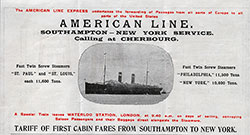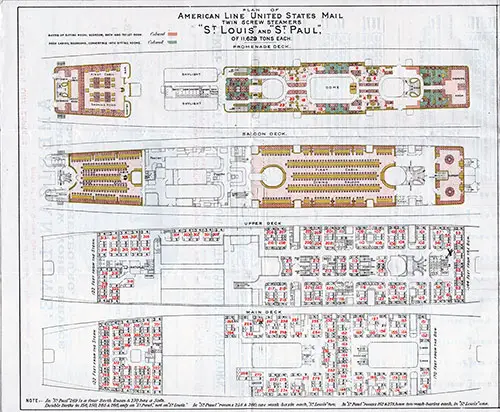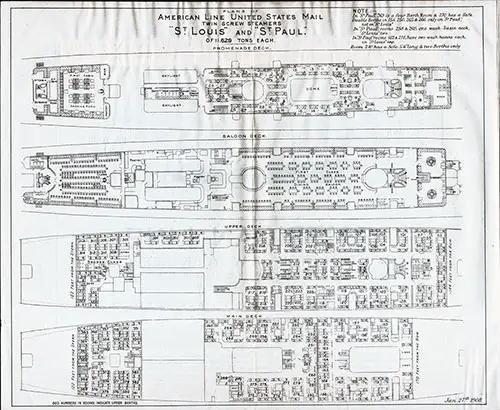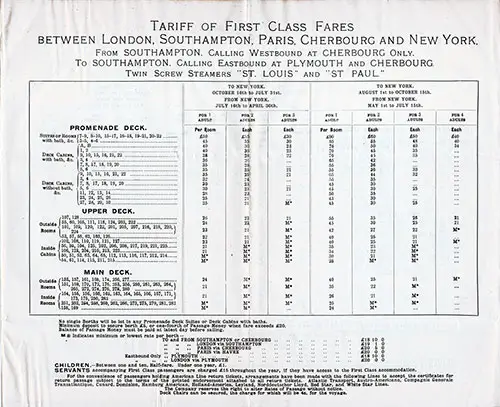SS St. Paul Archival Collection
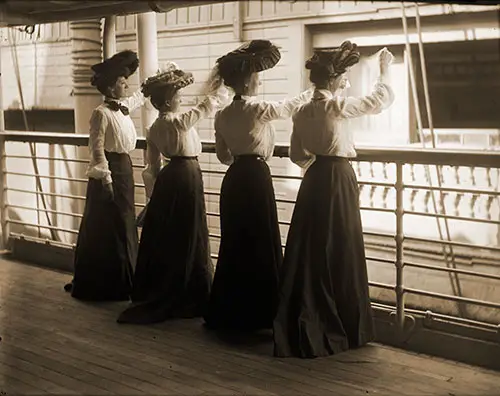
Four Women Waving from the Deck of the SS St. Paul of the American Line ca. 1900. Photo by William M. Vander Weyde. George Eastman House Collection. | GGA Image ID # 210f655100
St. Paul (1895) American Line
Built by Wm. Cramp & Sons Shipbuilding & Engineering Co., Philadelphia, Pa. Tonnage: 11,629. Dimensions: 535' X 63'. Propulsion: Twin-screw, 21 knots. Quadruple expansion engines. Masts and Funnels: Two masts and two funnels. Passengers: 220 first, 220 second, 800 third. Crew: 377 members. Launched: on April 10, 1895. Not in March 1895, when an attempt was made. Maiden voyage: New York-Southampton, October 9,1895. War Service: Served as auxiliary cruiser during Spanish-American War. Sunk the British cruiser Gladiator, by colliding of the Isle of Wight during a storm, April 25, 1908. The Gladiator lost 27 men and the St. Paul underwent repairs before returning to service. As the United States transport Knoxville, during World War I, she capsized (April 1918) alongside a New York pier. Repairs and Reconditioning: Subsequently refloated and reconditioned for trans-Atlantic service. Post War Service: Made her re-entry New York-Cherbourg-Southampton run route, in March 1920. Fate: Scrapped in Germany, 1923. Sister ship: St. Louis.
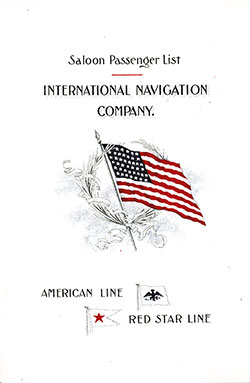
1899-10-18 SS St. Paul Passenger List
- Steamship Line: American Line
- Class of Passengers: Saloon
- Date of Departure: 18 October 1899
- Route: New York to Southampton
- Commander: Captain John C. Jamison
1901-04-22 American Line First Cabin Services
1901 Brochure covers First Cabin Travel on the Steamships of the American Line and includes Deck Plans, Rates for Transatlantic Travel (Southampton - New York Service via Cherbourg) and General Passenger Information. Ships Covered: St. Louis, St. Paul, and New York.

1901-09-28 SS St. Paul Passenger List
- Steamship Line: American Line
- Class of Passengers: Saloon
- Date of Departure: 28 September 1901
- Route: Southampton to New York via Cherbourg
- Commander: Captain John C. Jamison

1902-12-06 SS St. Paul Passenger List
- Steamship Line: American Line
- Class of Passengers: Saloon
- Date of Departure: 6 December 1902
- Route: Southampton to New York via Cherbourg
- Commander: Captain John C. Jamison

1904-12-10 SS St. Paul Passenger List
- Steamship Line: American Line
- Class of Passengers: Second Class
- Date of Departure: 10 December 1904
- Route: Southampton to New York via Cherbourg
- Commander: Captain F. M. Passow

1907-07-20 SS St. Paul Passenger List
- Steamship Line: American Line
- Class of Passengers: Second Class
- Date of Departure: 20 July 1907
- Route: Southampton to New York via Cherbourg
- Commander: Captain F. M. Passow

1907-11-09 SS St. Paul Passenger List
- Steamship Line: American Line
- Class of Passengers: Second Class
- Date of Departure: 9 November 1907
- Route: Southampton to New York via Cherbourg
- Commander: Captain F. M. Passow
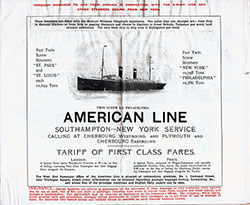
1908-05-22 - American Line Southampton to New York Service
Broadside Flyer produced by the American Line promoting their Southampton - New York service. Includes information for passengers, the tariff of first-class fares, and deck plans for the SS St. Louis, SS St. Paul, SS New York, and the SS Philadelphia.

1911-07-15 SS St. Paul Passenger List
- Steamship Line: American Line
- Class of Passengers: Second Class
- Date of Departure: 15 July 1911
- Route: Southampton to New York via Cherbourg
- Commander: Captain F. M. Passow

1911-08-16 SS St. Paul Passenger List
- Steamship Line: American Line
- Class of Passengers: First Class
- Date of Departure: 16 August 1911
- Route: Southampton to New York via Cherbourg and Queenstown (Cobh)
- Commander: Captain F. M. Passow

1914-05-27 SS St. Paul Passenger List
- Steamship Line: American Line
- Class of Passengers: Second Class
- Date of Departure: 27 May 1914
- Route: Southampton and Cherbourg to New York via Queenstown (Cobh)
- Commander: Captain F. M. Passow

1916-09-09 SS St. Paul Passenger List
- Steamship Line: American Line
- Class of Passengers: First and Second Class
- Date of Departure: 9 September 1916
- Route: Liverpool to New York
- Commander: Captain A. R. Mills
Deck Plans
Deck Plan of the SS St.Louis and the SS St. Paul of the American Line. Dated 22 April 1901. | GGA Image ID # 1144aedaba. Click to View Larger Image.
Deck Plans of American Line United States Mail Twin Screw Steamers "St. Louis" and "St. Paul" of 11,629 Tons Each. Diagram Includes Promenade, Saloon, Upper, and Main Decks. Dated 27 January 1908. | GGA Image ID # 11492171b6. Click to View Larger Image.
Tariff of First Class Fares Between London, Southampton, Paris, Cherbourg and New York. From Southampton. Calling Westbound at Cherbourg Only. To Southampton. Calling Eastbound at Plymouth and Cherbourg. Twin Screw Steamers "St. Louis" and "St Paul" - 1908. | GGA Image ID # 11498fa506. Click to View Larger Image.
Sailing Schedules
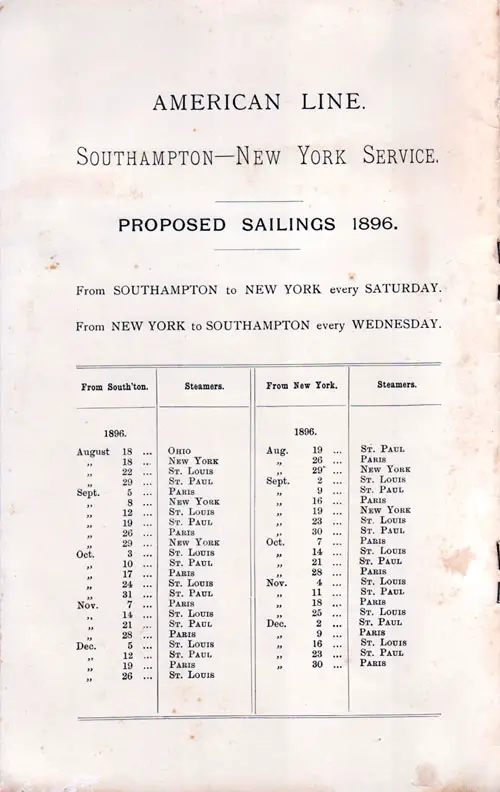
Sailing Schedule, Southampton-New York Service, from 18 August 1896 to 30 December 1896. Ships Included the Ohio, New York, Paris, St. Louis, and St. Paul. SS Paris Passenger List, 15 August 1896. | GGA Image ID # 1e449f2aad
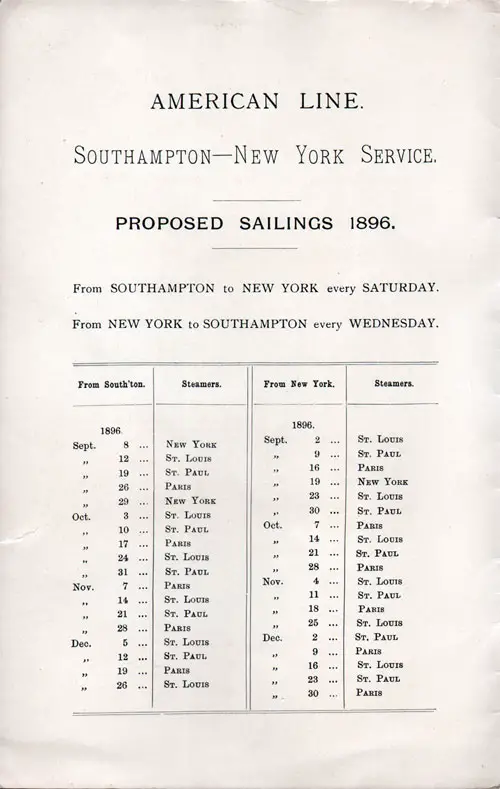
Sailing Schedule, Southampton-New York Service, from 8 September 1896 to 30 December 1896. Ships Included the New York, Paris, St. Louis, and St. Paul. SS Paris Passenger List, 5 September 1896. | GGA Image ID # 1e44bce4ca
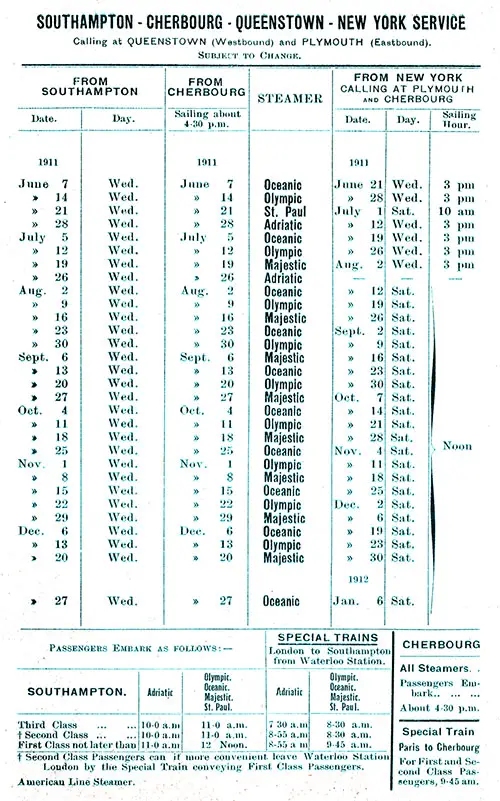
Sailing Schedule, Southampton-Cherbourg-Queenstown (Cobh)-New York, from 7 June 1911 to 6 January 1912. Ships Included the Adriatic, Majestic, Oceanic, Olympic, and St. Paul. SS Canopic First Class Passenger List, 23 July 1911. | GGA Image ID # 211f985a63
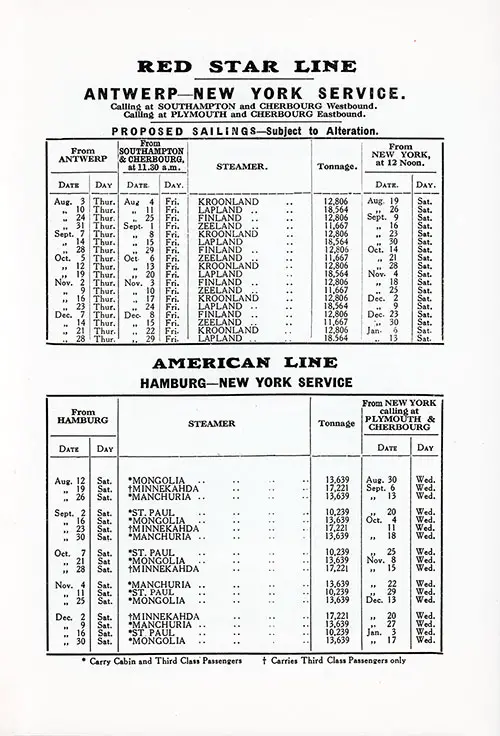
Proposed Sailings. Red Star Line: Antwerp-New York Service from 3 August 1922 to 13 January 1923. American Line: Hamburg-New York Service from 12 August 1922 to 17 January 1923. Ships Included the Red Star Line Finland, Kroonland, Lapland, and Zeeland. Ships for the American Line Manchuria, Minnekahda, Mongolia, and St. Paul. RMS Majestic Passenger List, 6 September 1922. | GGA Image ID # 1dd525c9ba
The New Ocean Steamers St. Louis and St. Paul, 1894
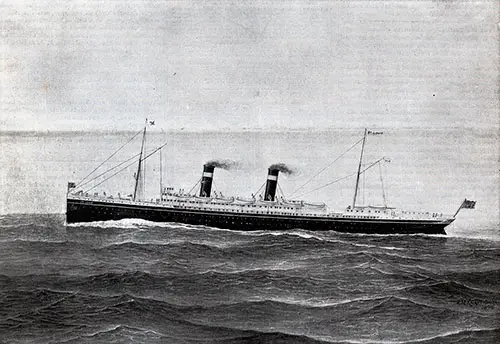
The New American Atlantic Liner St. Louis. | GGA Image ID # 13eb90e399
The necessity for the immediate encouragement for the building, by American citizens, of a fleet of ocean steamships, capable of the highest speed, and constructed with special reference to government naval service, in case of war, led the Congress of the United States, in 1892, to enact certain special laws upon the subject.
Authority was given to the International Navigation Company, of Philadelphia, at once to place under the American flag two of its fast English-built vessels, the New York and the Paris, provided others of equal or higher class should be promptly constructed in this country.
Thereupon the company entered into contracts with the Messrs. Cramp, of Philadelphia, for the construction of several new vessels, which are now under construction.
The first two of these, the St. Louis and the St. Paul, are now approaching completion. Herewith we present a drawing of one of these vessels, the St. Louis. The following particulars we derive from the Steamship :
The St. Louis and St. Paul are the first transatlantic passenger steamers to be built in the United States for a period of over twenty years, and they will be compared with the most recent productions of British shipbuilders, which represent the culmination of their skill and experience.
They are the largest vessels ever constructed in America, their principal dimensions being : Length over all, 554 feet; length on load water line, 536 feet; extreme breadth, 63 feet; moulded depth, 42 feet; tonnage, gross register, 11,000 tons.
The hull of each vessel is to have a double bottom constructed on the cellular principle, subdivided by athwartship bulkheads and a longitudinal division arranged for heeling purposes, the whole to be available for water ballast.
In designing these vessels special attention has been given to the question of safety under all conditions. They are so subdivided by transverse bulkheads that even in the event of a collision and injury to a bulkhead, whereby two compartments might fill with water, the ship would still float in perfect safety.
They will have a straight stem and elliptical stern, topgallant forecastle and poop, with close bulwarks fore and aft, two pole masts, and two lofty smoke pipes or funnels.
There will be promenade, saloon, upper, main, and orlop decks, the three first-named to be plated from end to end. The main deck will be plated for the length of the machinery spaces, and will have stringers and tie plates beyond. Wood planking will be laid on all decks.
The promenade deck will remain unbroken the whole length of the vessel. Arrangements have been made in each of the vessels for carrying about 320 first-class and 200 second-class passengers, and 900 emigrants.
The first-class passengers will occupy the center of the vessel, the second class will be between the stern and the center, and emigrants will occupy the ends of the vessel.
The main saloon, which is large enough to seat all the first-class passengers at once, will be on the upper deck forward, and will be arranged with a large dome in the middle, so that the appearance of the interior will be that of an immense hotel dining hall.
The second-class saloon will also be on the upper deck, but toward the after end, and will be fitted up in the ordinary style of a first-class saloon on an Atlantic liner.
The first-class smoking room will be on the promenade deck aft, and will be furnished with everything that experience has taught contributes to the comfort of the passengers. Besides these there will be a library and drawing room, where the ladies and non-smokers may amuse themselves.
The engines of the new steamers will be the most powerful quadruple expansion marine engines in the world. They will probably develop about 10,000 I.HP. each.
The cylinders will be 36, 50, 71 and 100 inches respectively in diameter, with a piston stroke of 60 inches, two sets of engines being placed in each boat to turn the twin screws, which will be sectional with three blades.
Steam for the working of the main engines will be furnished at about 200 pounds pressure by six steel double-ended boilers, each 20 feet long and 15 feet 7% inches diameter; the battery to have 48 Purves furnaces 39 inches diameter, and to be fitted with Serve's patent tubes.
The total grate surface will aggregate about 830 square feet and the heating surface about 30,000 square feet. Piston valves will be fitted throughout and operated in the usual manner.
The crank shafts, eccentric straps and connecting rods will be of forged steel, and the piston rods will be of ingot steel. The valve gear will be of the link type, controlled by a steam cylinder and also by an auxiliary hand gear.
Many features will be added to insure the perfect working of these engines. The columns will be of cast steel forked at bottom. The thrust blocks will be of the usual horseshoe type, and the thrust shafts are to be about 13 feet long. The line shafting will be of forged steel, the bearings being of cast iron. The air pumps will be attached, but the condensers will be independent.
To support the outboard shaft bearings, the hull is built out in a horizontal web to a steel frame, having both bosses cast in one piece, and weighing about 68,000 pounds. The after deadwood is cut away, and the keel slopes up, so that the shoe meets the boss frame at the after end.
To comply with the terms of the contract, the builders will have to show, by an extended sea trial, that when working under ordinary sea-going conditions the vessels are to be easily capable of maintaining a speed of 20 knots per hour at sea.
Of course, the quadruple expansion engines of these twin screw vessels will be the most interesting feature, on account of the great power they are expected to develop.
This is the first time an effort has been made to use quadruple expansion in engines of over 4,000 I. H. P., and in only one or two instances has it been applied to engines of that power. In speaking of the vessels, Mr. Charles H. Cramp, in a paper read before the American Society of Naval Architects and Marine Engineers, said : "I will not venture prediction as to their probable performance, but I will guarantee them to be perfectly safe, comfortable and economical ships.
They are to be closely followed by other ships, which I will not now describe, except to say that they will not shrink from comparison or competition. The St. Louis and St. Paul have been especially arranged so as to be readily and quickly convertible into armed cruisers, carrying eight 6 inch 100 pound rapid-fire guns.
Also, the conditions of the mail contract between the United States government and the International Navigation Company place at the disposal of the American navy these great ships, almost instantly convertible into commerce destroyers, averaging greater performance than the Columbia, which, with the three others that are about to follow as quickly as the plans can be completed, will practically re-enforce the United States navy by $21,000,000 worth of ships and not only without cost of building, but also without the expense of maintenance and commission in time of peace.
In conclusion, allow me to say that these ships will be American from truck to keelson. No foreign materials enter into their construction. They are of American model and design, of American material, and are being built by American skill and muscle.
Source: Scientific American: A Weekly Journal of Practical Information, Art, Science, Mechanics, Chemisty, and Manufactures, Copyrighted 1894 by Munn & Col, Vol. LXXI, No. 6, New York, 11 August 1894. Pages 81+

